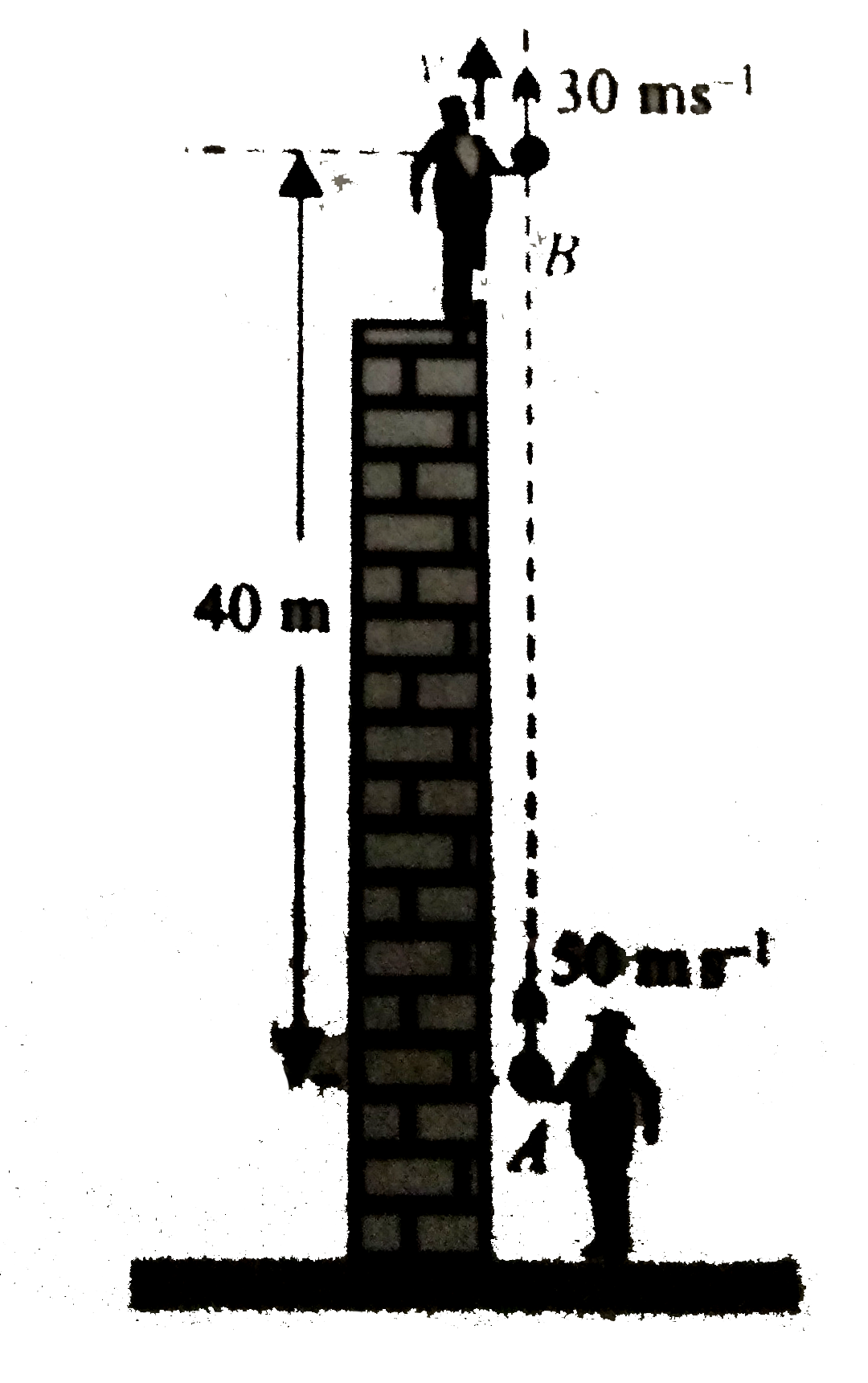Two balls of equal mass are projected upwards simultaneously, one from the ground with initial velocity 50ms−1 and the other from a 40m tower with initial velocity of 30ms−1. The maximum height attained by their COM will be a) 80 m b) 60 m c) 100 m d) 120 m
The initial position of centre of mass is
yic=m×0+m×402m=20m
Initial velocity of centre of mass
ucm=m×50+m×302m=40ms−1
Acceleration of centre of mass acm=−g
Using kinematics equation v2cm=u2cm+2a(cm)H
Here H is the maximum height reach by centre of mass of two balls from initial level.
∴02=402−2×10×H
⇒H=160020=80m
Hence maximum height reach by centre of mass from ground level will be
hmax=(hcm)initial+H=20+80=100m
Topper's Solved these Questions
- CENTRE OF MASSBOOK - CENGAGE PHYSICS ENGLISHCHAPTER - CENTRE OF MASSEXERCISE - Solved Examples
13 Videos
- CENTRE OF MASSBOOK - CENGAGE PHYSICS ENGLISHCHAPTER - CENTRE OF MASSEXERCISE - Exercise 1.1
20 Videos
- CALORIMETRYBOOK - CENGAGE PHYSICS ENGLISHCHAPTER - CALORIMETRYEXERCISE - Solved Example
13 Videos
- DIMENSIONS & MEASUREMENTBOOK - CENGAGE PHYSICS ENGLISHCHAPTER - DIMENSIONS & MEASUREMENTEXERCISE - Integer
2 Videos
Similar Questions
A body of mass 1kg initially at rest, explodes and breaks into three fragments of masses in the ratio 1:1:3. The two pieces of equal mass fly off perpendicular to each other with a speed of 15ms−1 each. What is the velocity of the heavier fragment?
View SolutionTwo children A and B of same mass (including their caps) M are sitting On a see-saw as shown in Fig. Initially, the beam is horizontal. At once, child B throws away his cap (mass M25) which falls at point Q, midpoint of the left half of the beam, due to this the balance of beam is disturbed. To balance it again what is the mass in required to be put at point P on the right half of the beam?

View SolutionA colorimeter contains 400g of water at a temperature of 5∘C. Then, 200g of water at a temperature of +10∘C and 400g of ice at a temperature of −60∘C are added. What is the final temperature of the contents of calorimeter?
Specific heat capacity of water −1000 cal/kg/K
Specific latent heat of fusion of ice =80×1000 cal/kg
Relative specific heat of ice =0.5
View SolutionTo find the distance d over which a signal can be seen clearly in foggy conditions, a railways-engineer uses dimensions and assumes that the distance depends on the mass density ρ of the fog, intensity (power/area) S of the light from the signal and its frequency f. the engineer finds that d is proportional to S1/n. the value of n is
View SolutionTwo balls of equal mass are projected upwards simultaneously, one from the ground with initial velocity 50ms−1 and the other from a 40m tower with initial velocity of 30ms−1. The maximum height attained by their COM will be
View SolutionTwo balls A and B of equal masses are projected upward simultaneously, one from the ground with speed 50ms−1 and other from height 40m above the first ball high tower with initial speed 30ms−1. Find the maximum height attained by their centre of mass.

View SolutionTwo bodies are thrown from the same point with the same velocity of 50ms^(-1) .if their angles of projection are complimentary to each other and the difference of maximum heights is 30m ,the minimum and maximum heights are (g=10 m//s^(2))
View Solution5A ball is thrown horizontally from a height of 20 m. It hits the ground with a velocity three times its initial velocity. The initial velocity of ball is
View SolutionA ball is thrown from the top of a tower with an initial velocity of 10 m//s at an angle of 30∘above the horizontal. It hits the ground at a distance of 17.3 m from the base of the tower. The height of the tower (g=10m/s2) will be
View SolutionA body is thrown horizontally from the top of a tower of 5 m height. It touches the ground at a distance of 10 m from the foot of the tower. The initial velocity of the body is
View SolutionTwo particles of same mass are project simultaneously with same speed 20ms^(-1) from the top of a tower of height 30m. One is projected vertically upwards and other projected horizontally.The maximum height attained by centre of mass from the ground will be (g=10ms^(-2))
View SolutionA ball thrown in vertically upward direction attains maximum height of 16 m. At what height would its velocity be half of its initial velocity ?
View SolutionTwo particles of same mass are projected simultaneously with same speed 20ms−1 from the top of a tower of height 20m. One is projected vertically upwards and other projected horizontally. The maximum height attained by centre of mass from the ground will be (g=10ms−2)
View SolutionA ball is thrown from the top of a tower with an initial velocity of 10 m//s at an angle of 30^(@) above the horizontal. It hits the ground at a distance of 17.3 m from the base of the tower. The height of the tower (g=10m//s^(2)) will be
View SolutionTwo balls of equal mass are projected upwards simultaneously, one from the ground with initial velocity 50ms−1 and the other from a 40m tower with initial velocity of 30ms−1. The maximum height attained by their COM will be a) 80 m b) 60 m c) 100 m d) 120 m
View SolutionA ball is thrown vertically upwards from the top of a tower with an initial velocity of 19.6m s−1. The ball reaches the ground after 5 s. Calculate the height of the tower . Take g=9.8ms−2 ?
View Solution

